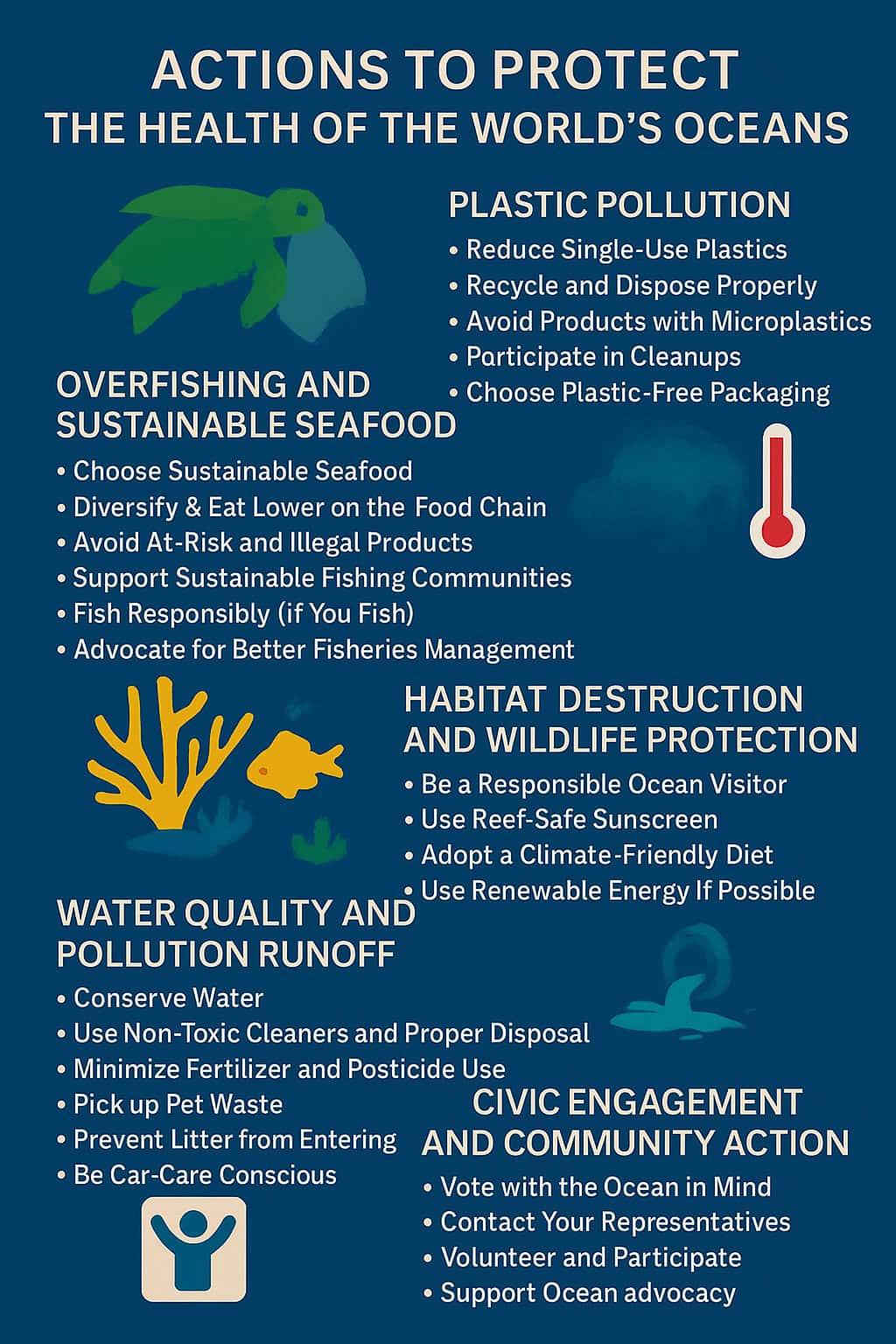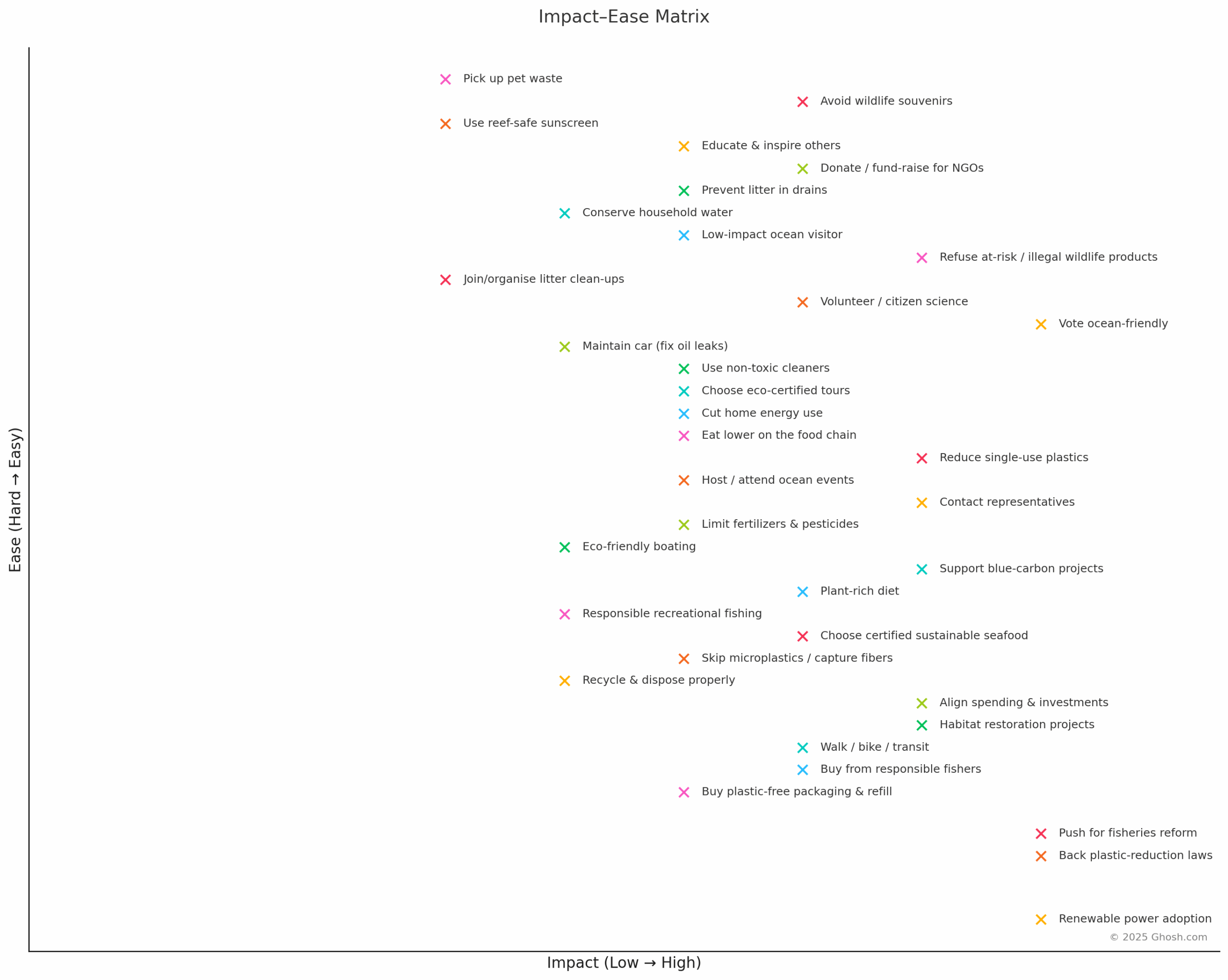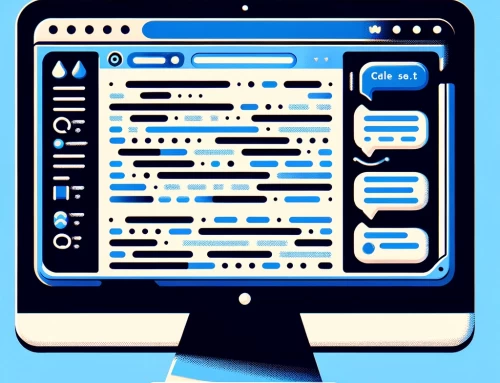Our oceans are sounding the alarm. With Sir David Attenborough’s forthcoming documentary Ocean—and the wake-up call of The End of the Line (2009) —it’s clearer than ever that the sea’s fate rests in our hands. This post rounds up a simple, issue-by-issue playbook of concrete steps anyone, anywhere can take to turn the tide and give our blue planet a fighting chance.
Plastic Pollution
A sea turtle mistakes a floating plastic bag for food. Plastic waste in oceans can be deadly to marine life. Plastic pollution is one of the greatest threats to ocean health, with an estimated 4–12 million metric tons of plastic entering the ocean each year. This litter injures marine animals and breaks down into microplastics that linger for decades. Here are ways individuals everywhere can fight plastic pollution:
- Reduce Single-Use Plastics: Cut down disposable plastic in your daily life. Refuse items like plastic bags, straws, bottles, and utensils when possible, and carry reusable alternatives (cloth shopping bags, refillable water bottles, metal straws, etc.). Small changes, like using a reusable bag or bottle, prevent waste from ever reaching the ocean and lower the amount of harmful microplastics in waterways.
- Recycle and Dispose Properly: Always dispose of trash in proper bins and recycle whenever facilities exist. If recycling isn’t available, ensure plastic waste is secured and not littered in the environment. Only about 9% of plastic is recycled worldwide, so recycling correctly (and buying products made of recycled materials) helps keep plastics out of oceans. Learn what your local recycling center accepts, and never dump trash or fishing gear into waterways.
- Avoid Products with Microplastics: Steer clear of personal care products containing microbeads or plastics (such as certain exfoliating scrubs or glitter), which wash down drains and pollute the sea. Even synthetic clothing sheds tiny fibers when washed. You can help by washing clothes less often, only in full loads, and using cold water and shorter cycles – this reduces the microfiber shedding from fabrics. Whenever possible, choose natural fibers or use laundry filters/bags to catch microfibers, preventing them from flowing out with wastewater.
- Participate in Cleanups: Join local beach, river, or neighborhood clean-up events to collect plastic litter before it reaches the ocean. Removing plastic debris from coastlines and communities makes an immediate impact. By volunteering for shoreline cleanups, you protect marine life from ingesting or getting entangled in trash. If no cleanup is happening near you, consider organizing one with friends or community members.
- Choose Plastic-Free Packaging: Support companies and products that use minimal or plastic-free packaging. For example, buy bar soap or shampoo in solid form instead of plastic bottles, or purchase foods in bulk with your own containers. Consumer choices send a message – when we buy less plastic, retailers and manufacturers are encouraged to offer sustainable packaging. Likewise, bring your own containers for take-out or leftovers to avoid Styrofoam and plastic waste.
- Support Plastic Reduction Policies: Use your voice to advocate for systemic change. Encourage local stores to provide plastic-free options and support legislation that limits single-use plastics and improves waste management. Many communities and countries have banned or taxed plastic bags, straws, and foam containers – these policies succeed when citizens speak up in favor. Sign petitions, vote for initiatives, or pressure companies to take responsibility for plastic waste (for example, through “extended producer responsibility” programs). Collective action can greatly reduce the amount of plastic entering our oceans.
Overfishing and Sustainable Seafood
Overfishing is depleting ocean life at an unsustainable rate – almost 35% of global fish stocks are overfished today. This threatens marine ecosystems and the food security of millions who depend on seafood. Individuals can help turn the tide by making responsible seafood choices and supporting sustainable fishing practices:
- Choose Sustainable Seafood: Whenever you eat fish or shellfish, opt for sustainably sourced options from well-managed fisheries. Look for ecolabels like the MSC blue fish or ASC certification that indicate the seafood was caught or farmed responsibly. If certifications aren’t common in your area, seek out local advice or guides (such as the Monterey Bay Aquarium’s Seafood Watch recommendations) to know which species are fished sustainably in your region. By choosing sustainably harvested seafood, you reduce demand for overfished species and support fishing communities that prioritize the ocean’s health.
- Diversify & Eat Lower on the Food Chain: Try eating a wider variety of seafood, focusing on abundant, fast-growing species instead of only popular high-demand fish. Smaller, fast-reproducing fish (like sardines or anchovies) or mollusks (like mussels) often have a lower impact on ecosystems and can be excellent protein sources. Reducing consumption of top predators (such as certain tuna or shark) gives those vulnerable populations a chance to recover. Even better, incorporate more plant-based proteins into your diet to take pressure off wild fisheries – for example, replacing a few seafood or meat meals each week with legumes or vegetables can help both ocean and climate.
- Avoid At-Risk and Illegal Products: Never buy or consume products derived from threatened marine species or harvested using destructive methods. This means steering clear of items like shark fins, sea turtle eggs or meat, whale products, or unsustainably harvested wild caviar. Likewise, avoid souvenir or jewelry items made from corals, shells, or turtle shell (bekko) – these often come from poaching and habitat destruction. By refusing to purchase such products, you remove the economic incentive for poachers and illegal fishing operations that harm ocean wildlife.
- Support Sustainable Fishing Communities: Whenever possible, buy seafood from local fishers who use sustainable techniques (such as line fishing, hand-harvesting, or well-managed traditional practices) rather than industrial fleets that may overharvest. Community-supported fisheries (CSFs), cooperatives, or local markets can directly connect you to fishers who care for the long-term health of the stock. Supporting these small-scale, responsible fishers helps strengthen sustainable livelihoods and encourages better management of marine resources.
- Fish Responsibly (if You Fish): For those who fish for recreation or subsistence, always follow local regulations like size limits, bag limits, and seasonal closures to avoid overharvesting. Practice catch-and-release for species that are undersized, threatened, or not intended for eating – use barbless hooks and handle fish gently to improve their survival. Never use illegal gear (such as dynamite, poisons, or fine nets that catch juvenile fish) and avoid damaging habitats when fishing (for instance, don’t trample seagrass beds or coral when collecting shellfish). Responsible fishing ensures healthy fish populations for the future.
- Advocate for Better Fisheries Management: Add your voice to calls for protecting ocean fish. Support the creation of marine protected areas and no-catch zones that allow depleted populations to rebound. Encourage your leaders to end harmful fisheries subsidies and crack down on illegal, unreported, and unregulated (IUU) fishing. By pushing for science-based catch limits and enforcement of rules, citizens can help reform fisheries policies so that they balance today’s needs with tomorrow’s abundance.
Climate Change and Ocean Health
Climate change is profoundly affecting the oceans – from warming seas and shifting currents to ocean acidification (as excess CO₂ makes the water more acidic) and rising sea levels. These changes are already bleaching coral reefs, altering fish migration, and reducing oxygen in some waters. While climate change is a global challenge, individual actions matter in reducing greenhouse gas emissions and protecting ocean climate resilience:
- Conserve Energy at Home: Using less electricity and improving energy efficiency reduces your carbon footprint. Simple steps include switching to energy-efficient light bulbs and appliances, insulating your home to cut heating/cooling waste, and unplugging electronics when not in use. Don’t over-set your thermostat – keep temperatures moderate or use a fan instead of air conditioning when possible. Many of these steps save you money as well, and collectively they shrink demand for fossil-fueled power that contributes to global warming.
- Use Sustainable Transportation: Transportation is a major source of carbon emissions. Whenever feasible, walk, bike, or use public transit instead of driving – especially for short trips. If you must drive, try to carpool or use a fuel-efficient vehicle to reduce pollution. In many cities, organizing a carpool or taking a bus/train can significantly cut down the CO₂ released per person. Fewer emissions from vehicles means less heat and carbon absorbed by the oceans (since the ocean takes up a large share of the world’s CO₂ and excess heat).
- Adopt a Climate-Friendly Diet: What you eat can impact the climate. Meat (particularly beef and lamb) production generates high greenhouse gas emissions, from methane in livestock to deforestation for grazing. Try shifting towards a plant-rich diet with more vegetables, fruits, grains, and legumes, and moderate your intake of red meat. As an alternative protein, sustainably sourced seafood or plant-based proteins have a much lower carbon footprint than industrial beef. For example, wild-caught seafood’s emissions are six times lower than beef’s on average. Eating lower on the food chain (more plants) and wasting less food both help combat climate change – which in turn helps protect ocean ecosystems stressed by warming and acidification.
- Use Renewable Energy if Possible: If you have the option, choose electricity from renewable sources (many places allow you to opt into a green energy plan or purchase solar/wind credits). Installing solar panels or solar water heaters, if affordable and viable, is another way to directly reduce fossil fuel use. Even in areas without these options, you can support community projects for solar lighting, biogas, or other clean energy. Reducing reliance on coal, oil, and gas for energy lowers carbon emissions that would end up heating and acidifying the ocean.
- Support “Blue Carbon” and Reforestation: Protect and restore carbon-absorbing ecosystems that buffer climate change. Planting trees is great, but equally important is supporting blue carbon ecosystems like mangrove forests, salt marshes, and seagrass beds. These coastal habitats trap large amounts of CO₂ and also guard against storm surges and erosion. You can volunteer for local tree-planting or wetland restoration projects, or simply help protect these areas by not disturbing them. For instance, if you live near mangroves, avoid cutting them down – and if there are community efforts to replant mangroves or restore coastal vegetation, consider joining in. Every mangrove seedling or tree you help plant is a small step toward stabilizing the climate and safeguarding the shoreline.
Habitat Destruction and Wildlife Protection
Marine habitats – from coral reefs and seagrass meadows to mangrove forests and kelp beds – are being destroyed by human activities like coastal development, destructive fishing, pollution, and unsustainable tourism. When habitats disappear, so do the species that rely on them. Individuals can take action to protect ocean habitats and the creatures that live there:
- Be a Responsible Ocean Visitor: Whenever you enjoy the ocean – whether diving, snorkeling, boating, or exploring tide pools – take care not to harm marine life or habitats. Do not touch, step on, or collect corals when diving or snorkeling, as even a slight touch can damage these fragile animals. Keep a respectful distance from wildlife; for example, observe dolphins, turtles, and seals without chasing or harassing them. Never feed wild marine animals (it disrupts their natural behavior). By being a mindful swimmer or tourist, you ensure your enjoyment doesn’t unintentionally hurt reef or shore ecosystems.
- Use Reef-Safe Sunscreen: If you’re swimming in the ocean or visiting coral reefs, choose sunscreens that are mineral-based (zinc oxide or titanium dioxide) and free of chemicals like oxybenzone and octinoxate. Common chemical sunscreen ingredients can wash off your skin in the water and cause coral bleaching, DNA damage, and even kill coral larvae. Many popular beach destinations now ban toxic sunscreens due to these impacts. As an alternative, wear a rash guard or sun-protective clothing and seek shade, reducing the need for heavy sunscreen. This way, you protect your skin and the reef at the same time.
- Never Buy or Take Marine Wildlife Products: Avoid purchasing souvenirs or products that come from the destruction of marine life. Items like coral jewelry, shells, dried seahorses, shark teeth, tortoise-shell hair accessories (made from sea turtle shell), and manta ray gill plates often involve killing endangered creatures or wrecking habitats. Similarly, don’t support the aquarium trade or curio shops if they sell wild-caught tropical fish, live coral, or other reef species taken unsustainably. The rule is simple: if it’s taken from a coral reef or the ocean and isn’t meant to be eaten, leave it be. By reducing demand for these products, you help stop the incentive to destroy reefs and marine life for trinkets.
- Practice Eco-Friendly Boating: For those who boat, sail, or use personal watercraft, follow guidelines to protect habitats. Anchor in sandy or muddy areas away from sensitive habitats – dropping an anchor onto a coral reef or seagrass bed can crush or uproot it. Obey “no-wake” zones in coastal areas, which are there to prevent shoreline erosion and protect vulnerable animals like manatees. Never throw trash or fishing gear overboard; secure all items so nothing blows into the water. If you kayak or canoe in mangroves or shallow areas, use existing channels rather than dragging vessels over seagrass. Responsible boating prevents habitat damage and keeps coastal ecosystems intact.
- Support Habitat Restoration: Get involved in local projects to restore and preserve marine and coastal habitats. Many communities organize initiatives like mangrove planting, wetland cleanups, coral reef rehabilitation (through coral gardening or reef cleanups), and dune restorations. Participating in these not only helps the environment but also raises awareness in your community. If you’re not near a coast, you can still contribute by donating to reputable organizations that plant mangroves, restore oyster reefs, or protect important marine areas. Every new mangrove tree or restored oyster bed provides shelter for marine life and improves the overall health of the ocean.
- Choose Sustainable Tourism Operators: When traveling or engaging in ocean activities (diving tours, whale watching, etc.), do a bit of research and choose tour operators that follow eco-friendly practices. Look for certifications or reviews that indicate the operator respects wildlife guidelines, doesn’t dump waste, and contributes to conservation. For example, a good snorkeling tour will brief guests on reef etiquette (no touching coral, no littering) and maybe even participate in beach cleanups or citizen science. By giving your business to responsible ecotourism companies, you encourage the whole industry to value conservation over short-term gain.
Water Quality and Pollution Runoff
Much of the pollution harming the oceans actually starts on land. Runoff carrying fertilizers, pesticides, sewage, and other chemicals can contaminate coastal waters, cause toxic algal blooms, create low-oxygen “dead zones,” and even lead to reef damage. Every person can take straightforward actions to improve water quality and keep rivers and oceans cleaner:
- Conserve Water: Use water wisely at home to reduce the strain on local water treatment and to minimize polluted runoff. Simple steps like taking shorter showers, fixing leaks, and installing low-flow fixtures mean less wastewater entering streams and oceans. In arid regions, conserving water also leaves more freshwater in rivers to flow to estuaries (benefiting those coastal ecosystems). The goal is to ensure that only the necessary water goes down our drains – and during heavy rains, less excess runoff means fewer pollutants washed into waterways.
- Use Non-Toxic Cleaners and Proper Disposal: Opt for biodegradable, phosphate-free soaps, detergents, and cleaning products at home. Harsh chemicals from household cleaners can end up in sewage outflows or septic systems and eventually in the ocean, where they harm marine life. Similarly, avoid chemical pesticides or herbicides in your home and garden; try natural pest control and organic alternatives. Dispose of hazardous substances properly – motor oil, paint, solvents, batteries, and medications should never be poured down the drain or toilet. Many communities have collection programs for hazardous waste. By keeping toxins out of your trash and wastewater, you prevent them from leaching into rivers and seas.
- Minimize Fertilizer and Pesticide Use: If you have a lawn or garden, be mindful with fertilizers. Use organic compost or slow-release fertilizers in the smallest necessary amount, and avoid applying them right before rain. Excess fertilizers wash into water bodies, adding nitrogen and phosphorus that spur harmful algae growth (which can create dead zones and choke coral reefs). The same goes for pesticides – overuse can run off and poison aquatic life. Wherever feasible, plant native vegetation that often requires less fertilizer and pest control, and which helps absorb runoff. Even urban residents can help by supporting organic farming practices and reducing chemical use on household plants.
- Pick Up Pet Waste: If you have pets, always clean up after them, especially before rain. Pet waste left on the ground gets carried by rainwater into storm drains and streams, adding bacteria and nutrients to water bodies. These can contaminate swimming areas and contribute to algal blooms. Disposing of pet waste in the trash or designated bins keeps bacteria like E. coli out of waterways. It’s a small effort that makes a surprisingly big difference in local water quality.
- Prevent Litter from Entering Drains: Ensure that litter (cigarette butts, plastic wrappers, etc.) is not left on streets or sidewalks where it can wash into storm drains. Those drains often empty straight to rivers or beaches without treatment, so any trash can become marine debris. If you see litter near gutters or creek beds, pick it up – this is essentially a “mini cleanup” you can do anytime. Also, be mindful not to drop small items (bottle caps, food wrappers) outdoors. Keeping our neighborhoods clean means cleaner oceans down the line.
- Be Car-Care Conscious: Automobiles can be a source of water pollution. If you wash your car at home, do it on grass or a permeable surface rather than on the street – the soil can filter soap and grime, preventing it from gushing into storm drains. Even better, use a commercial car wash which typically treats and recycles water. Check your car for oil leaks and fix them promptly; leaked oil on driveways gets swept into waterways when it rains. When it’s time to refill antifreeze or other fluids, handle carefully and clean up any spills. These measures keep toxic automotive fluids from ending up in streams and estuaries.
Civic Engagement and Community Action
Protecting the world’s oceans isn’t just about our individual habits – it’s also about coming together to advocate for bigger changes. Everyday people, no matter where they live, have the power to influence policy, corporate behavior, and community priorities. Civic engagement amplifies your impact from local beaches to the global stage. Here’s how you can get involved:
- Vote with the Ocean in Mind: Use your voting power to support leaders and policies that prioritize ocean health, climate action, and environmental justice. Research candidates’ stances on issues like marine conservation, pollution control, and climate change, and vote for those with strong ocean-friendly agendas. For instance, some local elections may involve referendums on plastic bag bans or funding for water treatment infrastructure – participating in these decisions directly helps your community protect its waters. Remember that voting isn’t just a right; it’s a tool to shape policies that can curb overfishing, reduce emissions, and establish marine protected areas.
- Contact Your Representatives: Don’t wait for election day to make your voice heard – contact local and national lawmakers regularly about ocean issues you care about. Write emails, make phone calls, or meet in person if possible, to urge officials to support legislation that addresses problems like plastic pollution, sewage treatment, overfishing, or climate change impacts on oceans. You can, for example, advocate for laws that restrict single-use plastics, or push for stronger protections for endangered marine species. Personal messages from constituents can influence a representative’s priorities. Be polite, concise, and clear about what action you want them to take.
- Volunteer and Participate: Hands-on involvement is a powerful way to contribute. Join local environmental groups or community science projects related to water and ocean conservation. You might volunteer to help restore a wetland, count sea turtle hatchlings, monitor coral reefs, or clean up a beach/river in your area. Urban dwellers can engage in community gardens (to reduce polluted runoff) or park cleanups. Not only do these activities directly improve the environment, they also connect you with like-minded people and increase public visibility of ocean issues. Many organizations provide training for citizen scientists – for example, you could help track marine debris or report whale sightings (as in some coastal communities’ apps) to aid research.
- Support Ocean Conservation Organizations: Consider contributing to NGOs and groups working to protect ocean health. Support comes in many forms – donating money if you have the means, fundraising, signing petitions they circulate, or volunteering your skills. Whether it’s an international charity planting mangroves or a local scuba club building artificial reefs, these organizations amplify individual efforts. Even spreading their campaigns on social media helps. Supporting groups like Oceana, WWF, Coral Reef Alliance, or local marine institutes can fund critical research and conservation projects. If donating isn’t feasible, giving time or even just lending your voice to their causes is valuable.
- Educate and Inspire Others: Share your knowledge and passion for the ocean with friends, family, and your community. Talk to your kids or younger relatives about why the ocean matters – for example, explain how it provides oxygen and food, and why we shouldn’t litter. Encourage others to adopt the ocean-friendly habits you practice, like reducing plastic use or eating sustainable seafood. Sometimes a friendly conversation or a social media post about an ocean documentary or an article can spark interest in someone who never thought about these issues. The more people understand the challenges (and solutions), the more momentum we build for change. Education can be as simple as recommending a good ocean-themed book, hosting a screening of a film like “Mission Blue,” or just sharing positive news about conservation successes to keep everyone motivated.
- Organize or Attend Community Events: Help build a community around ocean stewardship. You might organize a local event for World Oceans Day (June 8th) or join a march/rally for climate and ocean action. Community meetings about local environmental issues (like a proposal for coastal development or a new marina) are also key places to speak up – show up and voice concerns if a project may harm water quality or habitats. By being active in town halls, public comment periods, or school board meetings (for including ocean/environment topics in education), you ensure that everyday citizens’ perspectives on ocean health are heard in decision-making processes. Grassroots action often drives leaders to take bolder steps.
- Live by Example (Consume & Invest Responsibly): Finally, use your personal consumption and even your financial choices as a form of advocacy. Support businesses that are ocean-conscious – for instance, patronize restaurants that source sustainable seafood or shops that minimize plastic packaging. Conversely, let companies know when you avoid their product due to unsustainable practices. If you have savings or investments, consider ethical investment funds that avoid industries like heavy polluters or overfishing operations. When companies see consumers caring about the ocean, it pushes them to improve practices. Every choice, from the clothes you wear (perhaps made of organic or recycled materials) to the sunscreen you buy, sends a message. Living by example not only reduces your own impact, it also quietly influences others around you to do the same.
Each of these actions, whether personal or collective, contributes to a healthier ocean. By reducing pollution, supporting sustainable practices, and speaking up for smarter policies, everyday individuals all around the world can help reverse the negative trends facing our blue planet. The key is consistency and community: small actions become powerful when millions join in. The ocean’s challenges are global, but so is our ability to solve them – every positive change, no matter how small, adds up to make a big difference.

External Resources
1 Plastic Pollution & Waste Reduction
-
Plastic Free July – global challenge with practical tips to cut single-use plastics.
https://www.plasticfreejuly.org -
Break Free From Plastic – movement directory, policy toolkits, brand-audit guides.
https://www.breakfreefromplastic.org -
5 Gyres Institute – science-based research on plastic pollution, action guides, microplastics toolkits.
https://www.5gyres.org -
The Ocean Cleanup – large-scale river and ocean plastic-capture projects, volunteer & donation portal.
https://theoceancleanup.com -
Surfrider Foundation / Rise Above Plastics – local U.S. chapters, beach-cleanup calendar, policy playbooks.
https://www.surfrider.org
2 Sustainable Seafood & Overfishing
-
Seafood Watch (Monterey Bay Aquarium) – regional seafood ratings apps, printable pocket guides.
https://www.seafoodwatch.org -
Marine Stewardship Council (MSC) – global wild-catch ecolabel standards, certified-fishery finder.
https://www.msc.org -
Aquaculture Stewardship Council (ASC) – responsible-farmed-seafood certification and product locator.
https://www.asc-aqua.org -
Global Fishing Watch – free AIS-based map to detect illegal, unreported and unregulated (IUU) fishing.
https://globalfishingwatch.org -
FishChoice – B-to-B sustainable-seafood supplier directory; good for restaurants and buyers.
https://www.fishchoice.com
3 Climate Change & “Blue Carbon”
-
Blue Carbon Initiative – coalition restoring mangroves, seagrass and salt-marsh ecosystems; project map + manuals.
https://www.thebluecarboninitiative.org -
Project Drawdown / Oceans – ranked solutions (e.g., offshore wind, dietary shifts) with impact data.
https://drawdown.org/sectors/oceans -
UN Ocean Decade Climate Program – research networks tackling ocean-climate nexus (grants, events).
https://oceandecade.org -
Climate Action Tracker – tracks national pledges vs 1.5 °C; helpful for advocacy letters.
https://climateactiontracker.org
4 Habitat & Wildlife Protection
-
Reef Check – citizen-science reef monitoring, volunteer diver training in 40 + countries.
https://www.reefcheck.org -
Coral Reef Alliance – community-based reef conservation projects, best-practice toolkits.
https://coral.org -
Mangrove Action Project – restoration manuals, global map of mangrove-planting groups.
https://mangroveactionproject.org -
Marine Conservation Society (UK) – wildlife-friendly tourism code, Great British Beach Clean events.
https://www.mcsuk.org -
Sea Shepherd Global – direct-action vessel campaigns against illegal fishing and by-catch.
https://www.seashepherdglobal.org
5 Water Quality & Run-off
-
Waterkeeper Alliance – 300 + local “Riverkeeper / Baykeeper” groups; volunteer water-testing programs.
https://waterkeeper.org -
Ocean Wise Shoreline Cleanup (Canada, open globally) – DIY cleanup registration, data-reporting app.
https://shorelinecleanup.org -
EarthEcho Water Challenge – low-cost test kits for schools and community groups, global data platform.
https://www.monitorwater.org -
EPA Soak Up the Rain (U.S.) – guides for rain-garden, barrel and green-infrastructure projects that cut run-off.
https://www.epa.gov/soakuptherain
6 Citizen Science & Everyday Volunteering
-
iNaturalist / Marine projects – log marine species sightings; data feeds research & conservation.
https://www.inaturalist.org -
eOceans – dive-log & beach-survey app feeding global shark, ray and plastic datasets.
https://www.eoceans.co -
Ocean Conservancy – International Coastal Cleanup – world’s largest single-day beach-cleanup drive (every Sept).
https://oceanconservancy.org/trash-free-seas/international-coastal-cleanup -
Great Global Project for Citizen Science – searchable database of ocean-themed projects (e.g., microplastics, plankton).
https://scistarter.org/ocean
7 Policy, Advocacy & Education
- Sustainable Ocean Alliance (SOA) – global youth-led network offering micro-grants, accelerators, and local “Ocean Hub” chapters that drive policy advocacy, entrepreneurship, and community projects for a regenerative ocean.
https://www.soalliance.org - High Seas Alliance – information hub on the UN High Seas Treaty, action alerts, briefing papers.
https://www.highseasalliance.org - Pew Charitable Trusts – Ocean Protection – policy research on fisheries subsidies, MPAs, seabed mining.
https://www.pewtrusts.org/en/topics/oceans -
Oceana – global campaigns on plastics, by-catch, climate; petition center and local chapters.
https://oceana.org -
UN Sustainable Development Goal 14 (Life Below Water) – official targets, progress dashboard, partnership registry.
https://sdgs.un.org/goals/goal14 -
Ocean Literacy Portal (UNESCO/IOC) – free curricula, multimedia, and training on ocean science for educators.
https://oceanliteracy.unesco.org
8 Zero-Waste & Reuse Shopping Tools
-
Loop by TerraCycle – refill-and-return grocery platform (US/EU/Asia pilots).
https://loopstore.com -
BuyMeOnce – directory of long-lifetime products to avoid disposable goods.
https://buymeonce.com -
Package Free Shop (resources section) – beginner zero-waste checklists and product swaps.
https://packagefreeshop.com
9 Travel & Tourism Certifications
-
Green Fins – reef-safe standards and assessment reports for dive/snorkel operators in Asia, Middle East, Caribbean.
https://www.greenfins.net -
Global Sustainable Tourism Council (GSTC) – destination & tour-operator criteria, list of certified options.
https://www.gstcouncil.org -
Blue Flag Beaches & Marinas – searchable map of certified clean, well-managed beaches worldwide.
https://www.blueflag.global
10 Guides for Businesses & Investors
-
UN PRI – Sustainable Blue Economy Finance Principles – framework for banks and investors.
https://www.unepfi.org/blue-finance -
WWF Risk Filter Suite (Ocean Filter) – free tool for companies to assess ocean-related risks in supply chains.
https://riskfilter.org/oceans -
Plastic Disclosure Project (As You Sow) – benchmark for companies to measure & report plastic footprints.
https://www.plasticdisclosure.org
Please let me know if you have other suggestions for Actions or Resources!









Leave A Comment